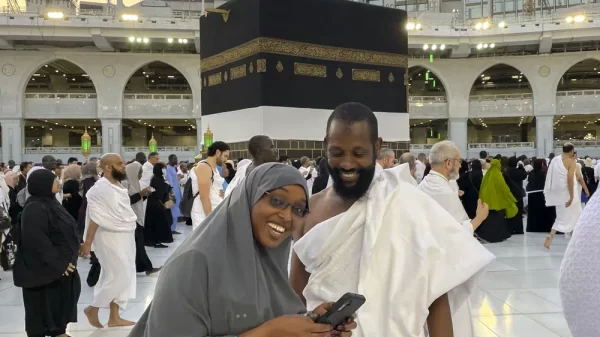Iraqi Christians clean the the roof of the Church of the Immaculate Conception in Qaraqosh, Iraq, Tuesday, Feb. 23, 2021. Pope Francis will visit the church during his historic trip to Iraq. Damaged during the Islamic State reign of terror, the church’s tragedy mirrored that of its Christian community which was devastated by the group. (AP Photo/Hadi Mizban)
The scenes are seared in the memory of the Rev. Ammar Altony Yako: A church that for decades has been the pride of the town of Qaraqosh, a center for Christian life in Iraq, stood badly scarred.
Yako saw it in 2016 when Qaraqosh was liberated from more than two years of Islamic State group rule. Scrawled on a wall was the proclamation, the “Islamic State will remain.” Strewn amid the rubble in a courtyard were bullet-riddled mannequins and other telltale signs of a militants’ makeshift firing range for target practice.
On Sunday, a new scene will play out for the world to watch at the Church of the Immaculate Conception and new memories will be created. Where the extremists once damaged, Pope Francis will now pray.
“I never could have imagined that his holiness, the pope, would visit this church, not even in my dreams,” said Yako, who has been overseeing reconstruction at the church. “It’s a very, very unexpected event and a very happy one.”
It is also one rich in symbolism.
Coming amid a pandemic and security challenges, the pope’s historic trip is taking him to Christian communities, like Yako’s, ravaged by the IS onslaught in 2014. Christians in the area were forced to escape ancestral towns and villages as the militants swept through northern Iraq. Many have since scattered abroad, their exodus fueling existential anxieties about Iraq’s already dwindling Christian population.
Many hope the pope’s trip can focus attention on their struggles and send a message of encouragement, but they also point to security, economic and social challenges deterring many Christians from returning.
Even now, some returnees wrestle with one particularly fraught question: Stay, helping keep ancient communities alive, or seek better lives abroad if they can?
Religious and historic sites of all kinds — including mosques, tombs, shrines and churches — suffered under IS. The extremist group damaged or destroyed whatever it considered contrary to its interpretation of Islam.
For Christians, the IS reign dealt a blow to a population already shrinking since the security breakdown and rise of militancy that followed the 2003 U.S.-led war in Iraq prompted many to leave. Iraqi Christians belong to various churches — such as Chaldean, Syriac, Assyrian and others — and trace the roots of their faith in the country back almost to the dawn of the religion itself.
In Qaraqosh, the Syriac Catholic Church of the Immaculate Conception — “al-Tahira al-Kubra” in Arabic — became a symbol of its community’s losses, and now of its efforts to bounce back.
After the area was taken back from IS, walls in the church were found charred, crosses broken, prayer books burned and the tower damaged, Yako said.
“It was so painful to see the church where we prayed and that we saw as part of our history looking like that,” he said. “At the same time, there was happiness that at least we were able to return and see it once more.”
Scars were erased as restoration happened with the help of international Christian organizations, Yako said. But some were kept to bear witness to the IS era, including pockmarked walls in the courtyard.
The church was built between 1932 and 1948. Local farmers set aside money from their harvest and women donated pieces of gold jewelry to help fund it, Yako said.
“Its construction was reliant on people volunteering and donating. Just like people think of building their own homes, they were building the house of God,” he said. “We call it the ‘mother church.’ Everyone feels like this church is their mother.”
More recently, local artists and others have been helping spruce up the church.
On 14 church windows, one artist has painted scenes from the Way of the Cross, evoking Jesus’ suffering on his way to be crucified.
Sculptor Thabet Mekhael made a statue of Virgin Mary, her palms open and her head adorned with a crown. The statue, around 4 meters (13 feet) tall, now stands atop the church’s tower surrounded by four crosses and looking out over Qaraqosh.
“The statue is a symbol of return and a symbol of our presence as Christians,” Mekhael said. “We’ve rebuilt the tower and made it even prettier than before.”
On a recent day, Sister Hayat Alkasmosa of the Dominican Sisters of St. Catherine of Siena, Iraq was among a group of volunteers hard at work sweeping and mopping the church’s floor.
“This church is like the heart of the area,” she said by phone. “It’s our life, our heritage, our mother.”
Alkasmosa’s voice cracked with emotion as she recalled crying when she learned the pope would visit Qaraqosh, also known as Bakhdida or Baghdeda.
“There’s a need for this kind of peace and consolation,” she said. “His presence is healing.”
Francis’ stop at the church, she said, will send a poignant message:
“Darkness cannot triumph and evil cannot win,” she said. “The last word is not for death; the last word is for life.”
Associated Press photographer Hadi Mizban in Qaraqosh contributed to this report.
Copyright 2020 Associated Press. All rights reserved.
